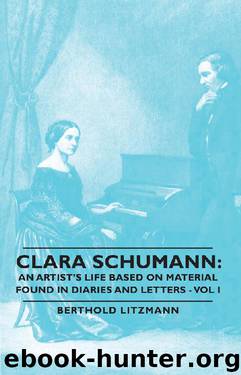Clara Schumann: An Artist's Life Based on Material Found in Diaries and Letters - Vol I: 1 by Bertholdd Litzmann

Author:Bertholdd Litzmann [Litzmann, Bertholdd]
Language: eng
Format: epub
Publisher: Read Books Ltd.
Published: 2013-04-16T03:00:00+00:00
1) Translator’s note: director of music.
1) A music-dealer.
1) Dr Gustav Schilling, music-teacher in Stuttgart since 1830, founder and “permanent secretary” of the German National Society of Music.
2) Jahrbüeher für Musik und ibre Wissenschaft.
1) Henriette Reichmann.
1) Hôtel Michadière, rue Michadière.
2) Pauline Garcia.
1) Probst, a friend of Wieck’s, who tried to influence Clara and make her think with her father, thus giving her much annoyance. Fechner, a cousin of Wieck’s second wife.
1) Rue Navarien No. 12. Clara went into the new house as early as March 26th. The Lists followed in the middle of April.
1) A singing-master.
2) Gesammelte Schriften II, 4. edition p. 59 etc.
3) The reference is probably to the article in Ges. Schr. II, p. 62 etc.
1) Ph. C. H. Potter, who since 1832 had been Director of the Royal Academy of Music in London.
1) Moritz August Schlesinger, proprietor of the music publishing house of that name, in Paris, and publisher of the Gazette musicale. The matinée at which Clara played was the third of a series of matinées which Schlesinger arranged for the subscribers to the Gazette musicale.
1) Alexander Batta, much admired in France as a ’cellist.
2) Alexander Joseph Artôt, a pupil of Kreutzer’s, an excellent violinist who died at 30.
3) Pierre Joseph Guilleaume Zimmermann, since 1816 Professor of piano-playing at the Conservatoire. His “Soirées” had a certain vogue, but one which Clara, on her first visit, found little justified. “On March 7th”, she writes in the diary, “there was an evening soirée at Zimmermann’s. So these are the soirées which are so famed in Germany? 150 ladies sit packed together in a tiny room, unable to move; and then there is music until late into the night; but what music! . . . . Arias, sung very badly, one after another. Rutini was the only one that gave me any pleasure, all the rest is worthless.”
4) Austrian ambassador.
5) Saxon ambassador.
1) August Franchomme, a famous ’cellist, a friend of Chopin’s.
2) G. M. Osborne from Limerick in Ireland, a pupil of Kalkbrenner’s, noted in his day as a pianist, and no less as a composer of drawing-room pieces.
3) Georg Amédee Matthias, born 1826, was a highly esteemed pianist in Paris, and in 1862 became Professor of piano-playing at the Conservatoire, but he was no second Liszt.
1) Ad. Nourrit, for a long time first tenor at the grand opera, and singing master at the Conservatoire, he was also the original Raoul in The Huguenots.
2) P. M. Baillot, first violin at the grand opera in the twenties and solo violinist in the royal orchestra.
3) This refers to a notice from St Petersburg in the N. Z. f. Mus. No. 13 (X p. 56) concerning the great successes of the beautiful Camilla Pleyel, of whom the writer remarks: “I found that Mad. Pleyel is among the best pianists of the present day, Henselt or A. Gerke alone she cannot make us forget.”
1) This sorely missed diamond ring, which Wieck had given her as a reward for her brave conduct on the Naumburg concert tour of 1836, she never received again.
Download
This site does not store any files on its server. We only index and link to content provided by other sites. Please contact the content providers to delete copyright contents if any and email us, we'll remove relevant links or contents immediately.
Waking Up in Heaven: A True Story of Brokenness, Heaven, and Life Again by McVea Crystal & Tresniowski Alex(37499)
Still Foolin’ ’Em by Billy Crystal(36057)
Cecilia; Or, Memoirs of an Heiress — Volume 1 by Fanny Burney(32078)
Cecilia; Or, Memoirs of an Heiress — Volume 3 by Fanny Burney(31470)
Cecilia; Or, Memoirs of an Heiress — Volume 2 by Fanny Burney(31420)
Fanny Burney by Claire Harman(26254)
Empire of the Sikhs by Patwant Singh(22775)
We're Going to Need More Wine by Gabrielle Union(18646)
Hans Sturm: A Soldier's Odyssey on the Eastern Front by Gordon Williamson(18334)
Plagued by Fire by Paul Hendrickson(17119)
Out of India by Michael Foss(16695)
All the Missing Girls by Megan Miranda(14798)
Cat's cradle by Kurt Vonnegut(14783)
Molly's Game by Molly Bloom(13895)
Pimp by Iceberg Slim(13803)
Bombshells: Glamour Girls of a Lifetime by Sullivan Steve(13701)
Leonardo da Vinci by Walter Isaacson(12815)
4 3 2 1: A Novel by Paul Auster(11817)
The Radium Girls by Kate Moore(11639)
